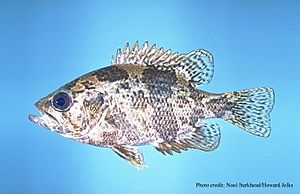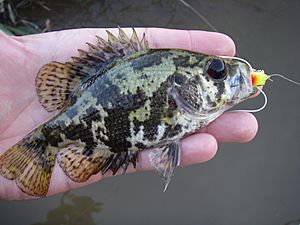Shadow bass facts for kids
Quick facts for kids Shadow bass |
|
|---|---|
 |
|
| Conservation status | |
| Scientific classification |

The shadow bass (Ambloplites ariommus) is a type of freshwater fish. It belongs to the sunfish family called Centrarchidae. This fish is special because it lives only in the southeastern United States.
Contents
About the Shadow Bass
The shadow bass has a special line on its side called a lateral line, with 36 to 42 scales. Its top fin, called the dorsal fin, has 11 sharp spines and 11 to 12 soft rays. The bottom fin, called the anal fin, has 6 to 7 spines and 10 to 11 soft rays.
This fish has a large mouth. Its upper jaw (called the maxilla) lines up with the middle of its eye. Shadow bass are usually olive green to light brown. They often have 2 to 4 dark brown stripes and spots on their sides. Their top, bottom, and tail fins are often clear or light yellow with black and gray spots.
The eye of the shadow bass has a reddish outer part (the iris) and a deep blue center (the pupil). There is also a black stripe that goes from under its eye to its gill cover. The spots on the scales of a shadow bass are shaped like triangles. This is different from the similar rock bass, which has rectangular spots.
The shadow bass is a medium-sized sunfish. It usually grows to about 10.16 centimeters (4 inches) long. The biggest ones can reach up to 30.48 centimeters (12 inches) and weigh about 0.45 kilograms (1 pound). Female shadow bass usually live longer than males. However, males grow faster and get bigger.
Where Shadow Bass Live
The shadow bass naturally lives in the southeastern United States. You can find them from the Apalachicola River area in Georgia all the way to the lower Mississippi River basin in Louisiana.
There are also two groups of shadow bass that live separately from the main population. These are found in the St. Francis, Black Arkansas Red, and upper Ouachita River areas in Missouri and Arkansas. In Tennessee, shadow bass live in most river systems south of the Tennessee River. They also live in the Blackwater and Chattahoochee Rivers in southern Georgia and northern Florida.
Shadow bass are usually not found in streams in the Black Belt area of Alabama. This is likely because these streams have low water flow and poor water quality during hot summer months. Changes to river channels might also affect where shadow bass live in the Mississippi River system.
Shadow Bass Environment and Food
The shadow bass is a freshwater fish that lives in areas with temperatures between 38 and 29 degrees North. It likes water that flows slowly over clean mud, sand, gravel, and small stones.
They prefer to live in brushy areas and pools with plants. They also like places with undercut banks and woody debris in small to medium-sized rivers and streams.
When they are small (less than 7.6 centimeters or 3 inches), shadow bass mostly eat tiny water bugs, especially crayfish. Once they grow bigger than 7.6 centimeters, they start eating small fish. These include fish like darters, madtoms, and minnows.
The main animal that hunts and competes with the shadow bass is the smallmouth bass. Both fish like to live in the same types of places. Scientists have studied what happens when rainbow trout are introduced into shadow bass habitats. The studies showed that the trout did not harm the shadow bass populations.
Things that humans do can cause the shadow bass population to decrease. These include changing river channels, dirt and mud getting into the water from logging, and building too close to their habitats.
Shadow Bass Reproduction and Life Cycle
Shadow bass usually spawn (lay eggs) from January to August. The exact time depends on the water temperature and where they live. In warmer southern areas like Alabama or Georgia, they spawn earlier. In colder northern areas, they spawn later when the water reaches the right temperature of 17-21°C (63-70°F).
When male shadow bass are ready to breed, the membranes of their pelvic (bottom front) and anal fins become darker. In females, these fins stay yellow or white.
Shadow bass become ready to reproduce when they are about one year old. A female can lay up to 1,330 eggs in one spawning season. After cold winters, females lay fewer, but larger, eggs. This means that the number of eggs that hatch is not affected by the temperature. This way, whether the winter is cold or mild, the shadow bass population stays strong and healthy.
Shadow Bass Family and Name
The shadow bass is part of the sunfish family, called Centrarchidae. It is closely related to the rock bass (Ambloplites rupestris) and one other species that lives naturally in the wild. The shadow bass was once thought to be a type of rock bass.
It was first officially described in 1936 by Peter Viosca Jr. The place where the first specimen was found, called the type locality, was Little Bogue Falaya Creek, about 3 miles north of Covington, Louisiana.
The first part of its scientific name, Ambloplites, comes from Greek words. Ambloo means "blunt," and oplites means "shield." The second part of its name, ariommus, means "large-eyed."
Shadow Bass and People
Protecting Shadow Bass
Even with its separate groups, the shadow bass is not considered to be in danger. It is listed as "G5 secure" by the government, which means it is very safe. The IUCN also says its status is "Least Concern", meaning it is not threatened.
In Mississippi, efforts are made to protect the pools where shadow bass live and to stop dirt from polluting their water. In most places, shadow bass are not a popular fish for sport fishing, so they don't get much attention for management.
However, in Missouri, where people do like to fish for shadow bass, scientists are studying their populations. They use methods like catching, marking, and releasing fish to learn more about them. They also collect information from anglers (people who fish) to decide if any rules are needed for shadow bass fishing.
Fishing for Shadow Bass
The world record for catching a shadow bass, according to the IGFA, is 0.82 kilograms (1 pound 13 ounces). This fish was caught in the Spring River in Arkansas.
- FishBase: Ambloplites ariommus
See also
 In Spanish: Ambloplites ariommus para niños
In Spanish: Ambloplites ariommus para niños


